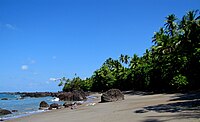
Photo from wikipedia
Osa Peninsula in remote southwest Costa Rica harbors 2.5% of global terrestrial biodiversity in only 1,200 km2 and has the largest remaining tract of Pacific lowland wet forest in Mesoamerica.… Click to show full abstract
Osa Peninsula in remote southwest Costa Rica harbors 2.5% of global terrestrial biodiversity in only 1,200 km2 and has the largest remaining tract of Pacific lowland wet forest in Mesoamerica. However, little is known about the marine ecosystems of this diverse region. Much of the coastline consists of soft sediment exposed to strong wave action. Three major hard bottom habitat types define this region, including: 1) coral reefs around Isla del Caño Biological Reserve, a no-take marine protected area (MPA) of 52 km2, 2) coastal rocky reefs and islets along the peninsula, including Corcovado National Park, and 3) submerged pinnacles just outside the Isla del Caño MPA. Average coral cover at Isla del Caño was 21%, composed primarily of Porites lobata and Pocillopora elegans. In contrast, coastal rocky reefs were dominated by turf algae (39.8%) and macroalgae (20.7%) with low coral cover (1.1%). Submerged pinnacles were dominated by crustose coralline algae (33.3%) and erect coralline algae (25.7%). Fish assemblage characteristics (species richness, abundance, biomass) were significantly higher at the pinnacles compared to the other habitats and was dominated by schooling species such as Haemulon steindachneri, and the herbivores Kyphosus ocyurus, and Acanthurus xanthopterus. Top predators, primarily Triaenodon obesus, Caranx sexfasciatus, and Lutjanus argentimaculatus, were also most abundant at these pinnacles and accounted for the largest differences in fish trophic structure among habitats. Despite Isla del Caño being fully protected from fishing, biomass was similar to fished areas along the coast and lower than the adjacent submerged pinnacles outside the reserve. Similarly, Corcovado National Park includes 20.3 km2 of no-take MPAs; however, there is limited enforcement, and we noted several instances of fishing within the park. The unique configuration of healthy offshore coral reefs and pinnacles connected to coastal habitats provides corridors for many species including large predators such as sharks and other marine megafauna, which warrants additional protection.
Journal Title: PLoS ONE
Year Published: 2022
Link to full text (if available)
Share on Social Media: Sign Up to like & get
recommendations!